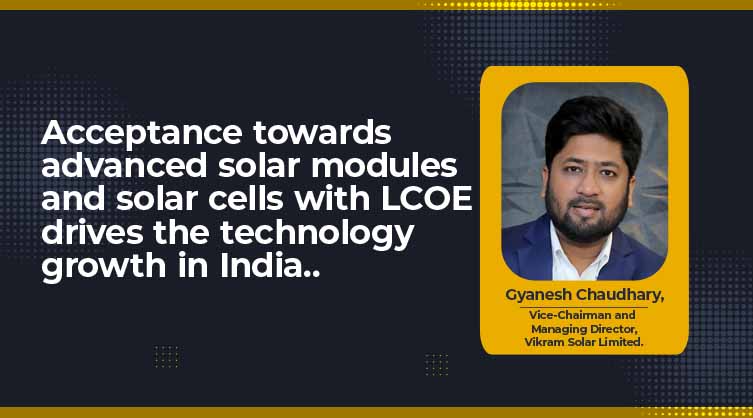Domestic solar manufacturers are well-poised to capitalise on key opportunities
By EPR Magazine Editorial April 26, 2022 3:24 pm IST
By EPR Magazine Editorial April 26, 2022 3:24 pm IST

Gyanesh Chaudhary, Vice-Chairman and Managing Director, Vikram Solar Limited. In an interview with EPR Magazine.
How do you evaluate the required role of solar + wind power in RE integrated new energy mix for a speedy energy transition?
The Government of India, under the leadership of Mr. Narendra Modi, Hon’ble Prime Minister, has accelerated the transition to clean energy with solar adoption. This is evident from the achievement of the COP21 target of 40 percent renewables by 2030, nine years ahead of schedule.
Solar has also surpassed 50 GW installation in India and has been at the forefront of leading this transition. India’s target of 500 GW renewable energy by 2030 and net-zero emission target by 2070 will bring incredible new opportunities for green energy’s growth. The Government is focused on strengthening the domestic solar eco-system and reducing India’s import dependence aligned to the Atmanirbhar Bharat vision.
What are the measures required to step-up RE power generation?
In order to achieve target of 500 GW renewable energy by 2030, announced at COP26 and enable the Aatmanirbhar Bharat vision, we are hopeful that the government will continue the targeted initiatives and policies to further strengthen the domestic solar manufacturing eco-system.
To enhance global competitiveness of domestic solar manufacturers, enhancing the export-incentive Remission of Duties or Taxes on Export Product (RoDTEP) rates and ensuring it includes AA (Advance Authorisation) along with SEZ are critical policy interventions. The government must consider allowing clearance from Special Economic Zones (SEZ) units to Domestic Tariff Areas (DTA) on a duty forgone basis. Additionally, we also recommend allowing conversion of SEZ units into DTA and permitting them to continue operating from the same infrastructure with enabling policies.Which innovations in new and upgraded products and equipment’s are driving the solar/wind energy sector?
The solar technology is rapidly evolving with a clear focus on reducing the Levelised Cost of Energy (LCOE). India is quickly showing inclination towards using monocrystalline modules that offer higher efficiency (24 percent).
At Vikram Solar, we are currently working on developing solar PV modules with higher Efficiencies using cell types such as n-type monocrystalline cell with Tunnel Oxide Passivated Contact (“TOPCON”) cell. TOPCON is a further higher efficiency technology which is naturally bifacial and superior in performance to the existing technologies. We have also collaborated with manufacturers of solar technology and institutes to conduct research study programmes.
How is technology enabling you in efficient and safe operations and maintenance?
We have a track record of being an early adopter in technology with manufacturing facilities based on global best practices.
To continue to deliver reliable and updated solar solutions to our customers, we are embracing new technologies. With artificial intelligence, cognitive modelling, machine learning, deep learning, virtual reality, augmented reality and robotic process automation, our R&D team has leveraged digitisation initiatives that allow seamless processes, such as implementation of six-sigma methods, lean manufacturing, reducing and regulating wastage. We are focusing on converging digital technologies with manufacturing operations. With this in mind, we have equipped our facility at Falta with digital production display board and AI-enabled image analytics.
We use cookies to personalize your experience. By continuing to visit this website you agree to our Terms & Conditions, Privacy Policy and Cookie Policy.